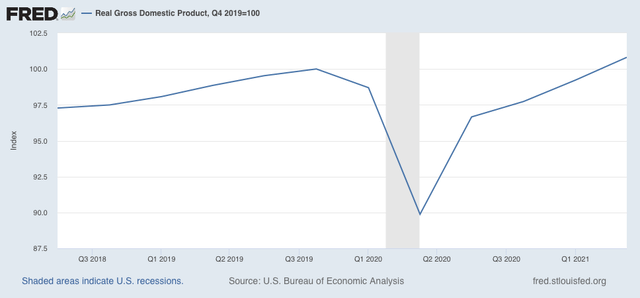Q2 2021 GDP: goodbye recession, hasta la vista recovery, hello expansion Nominal GDP before inflation increased 3.1%, while real GDP for the 2nd Quarter increased 1.6%. The real annual rate of growth was thus 6.5%. Real GDP is now 0.8% higher than its last quarter before the onset of the pandemic: The recession is over, as was declared by the NBER last week. In fact, so is the recovery, if one measures by GDP, since once all of the declines during the recession is made up, that qualifies for calling it an expansion. Real income and spending are also at higher levels than at any point before the recession, while industrial production and – especially – employment have continued to lag.
Topics:
NewDealdemocrat considers the following as important: 2021 GDP, US EConomics
This could be interesting, too:
NewDealdemocrat writes JOLTS revisions from Yesterday’s Report
Bill Haskell writes The North American Automobile Industry Waits for Trump and the Gov. to Act
Bill Haskell writes Families Struggle Paying for Child Care While Working
Joel Eissenberg writes Time for Senate Dems to stand up against Trump/Musk
Q2 2021 GDP: goodbye recession, hasta la vista recovery, hello expansion
Nominal GDP before inflation increased 3.1%, while real GDP for the 2nd Quarter increased 1.6%. The real annual rate of growth was thus 6.5%. Real GDP is now 0.8% higher than its last quarter before the onset of the pandemic:

The recession is over, as was declared by the NBER last week. In fact, so is the recovery, if one measures by GDP, since once all of the declines during the recession is made up, that qualifies for calling it an expansion.
Real income and spending are also at higher levels than at any point before the recession, while industrial production and – especially – employment have continued to lag.
